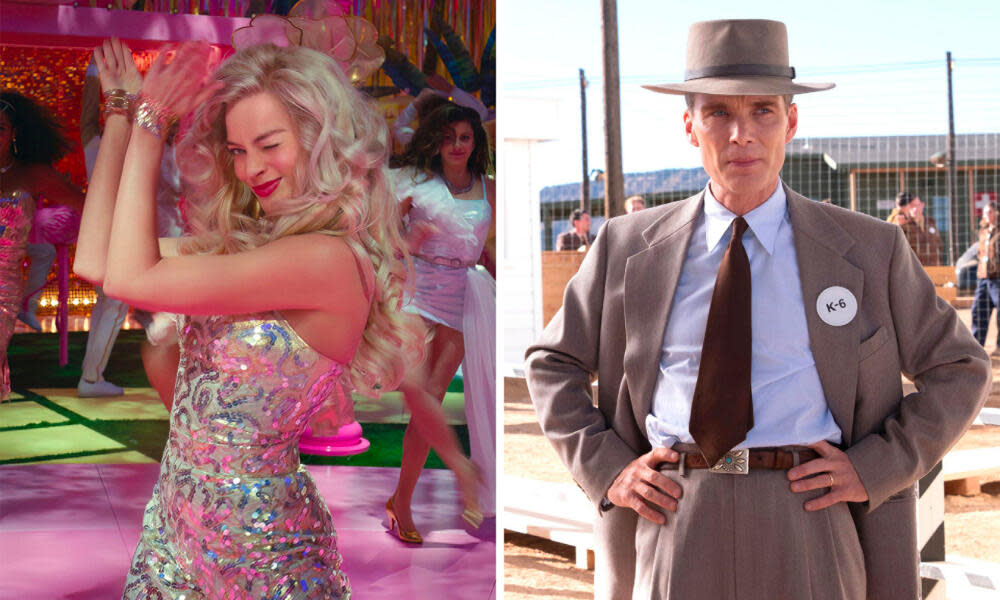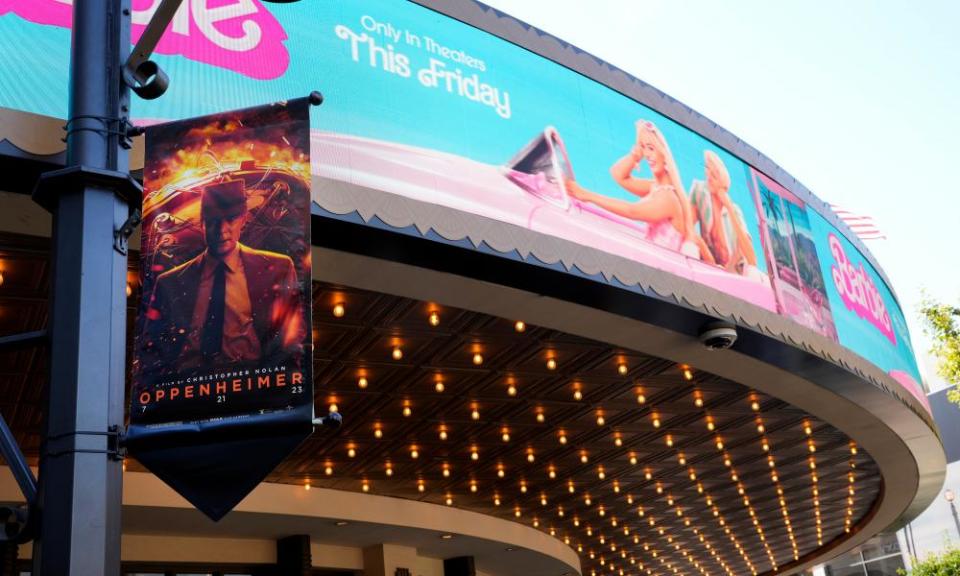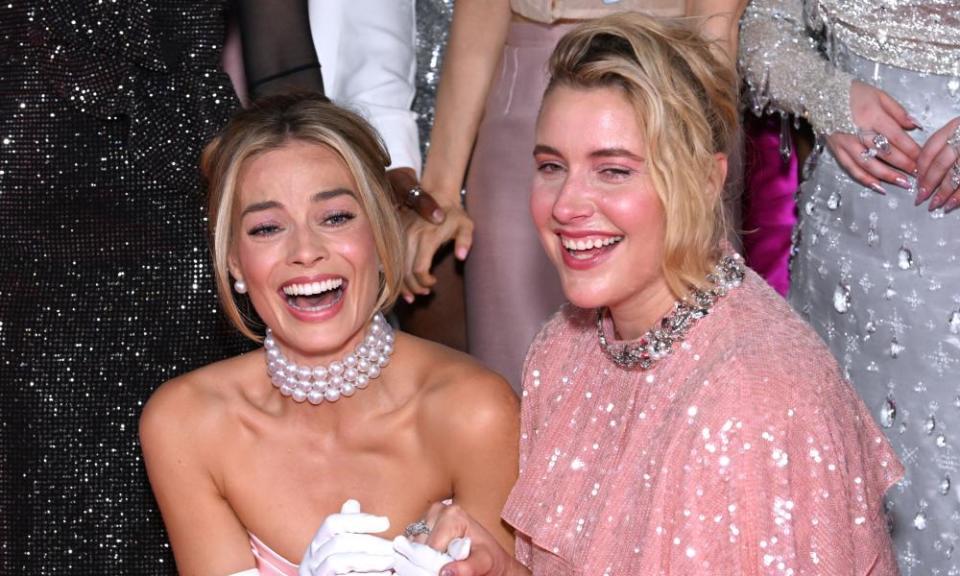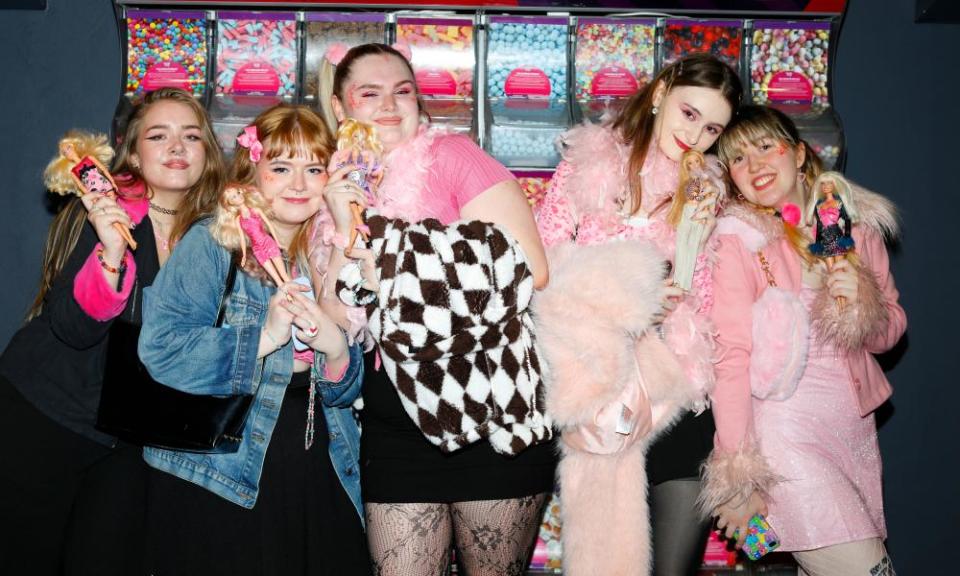Barbenheimer bonanza: how two films saved the summer box office

The past weekend wasn’t the first time that two major films had been released simultaneously but the big screen blitz of Barbie and Oppenheimer saw the first time audiences saw it less as a competition and more of a collaboration.
Related: I survived the Barbie-Oppenheimer double bill and I don’t recommend it | Stuart Heritage
Months ago, Barbie v Oppenheimer had been widely discarded for the cosier, Bennifer-adjacent Barbenheimer, the bomb-maker and the bombshell hand-in-hand, fans planning to watch them both rather than just one, an unprecedented event that had exhibitors and studios both geared up for a much-needed win. But even the most ambitious box office analysts couldn’t have predicted just what a win that was going to be, the higher end of estimates now looking positively conservative, the two films combining to shatter records and create a genuine, online-to-offline pop culture phenomenon.
Greta Gerwig’s gently satirical Mattel comedy was the inevitable No 1 but with a weekend haul of $162m in the US, it also became the year’s biggest opener to date as well as the highest-ever opening for a female director. Just as surprisingly, Christopher Nolan’s dark period drama managed an $82m second place win, a staggering amount for something of that ilk, a talky, 3-hour awards movie treated by audiences like a superhero epic. Globally, the picture was similarly rosy, the two films combining to bring in over $500m between them, a much-needed boost to what had been a mostly troubling summer at the box office.
While audiences had turned out en masse for superhero sequels Spider-Man: Across the Spider-Verse and Guardians of the Galaxy Volume 3 (although neither film has reached the magic $1bn global mark), they’d mostly stayed away from other tentpole offerings. DC’s beleaguered comic book mash-up The Flash sputtered out as the biggest superhero bomb of all time, set to lose $200m. Indiana Jones and the Dial of Destiny looked unlikely to prove profitable thanks to an exorbitant $300m budget and a worldwide gross not that much higher. Tom Cruise’s ultra-expensive Mission: Impossible sequel opened beneath projections and thanks to Barbenheimer, suffered a catastrophic second week drop. Animated adventures Elemental and Ruby Gillman, Teenage Kraken, came in way below expectations. Comedies such as Book Club: The Next Chapter, Joy Ride, The Blackening, The Machine and About My Father tanked in wide release. Before this weekend, ticket sales had been down 20% in comparison to the same point in 2019.

The industry has still been in recovery from the darkest days of the pandemic when cinemas were shuttered or re-opened with caveats or shuttered again, forcing confused or concerned audiences to stay at home and the studios to reconfigure release strategies. The shortening of the window from theatrical to home viewing, at times reduced to nothing with day-and-date releases available on both big and small screen, has for many made the cinema seem like an unnecessary and overpriced relic of the past, helped by streamers such as Netflix and Amazon releasing blockbuster-sized movies with stars to match straight-to-smartphone. The great disruptors as they were once known have became the great destructors, the subscription model unable to ever prove quite as profitable as the model it was aiming to replace.
But even in a year when the box office might be down, there were signs that it wasn’t out. Oscar films such as The Fabelmans, Tar and Women Talking might have stumbled during the dying months of 2022 but 2023 kicked off with B-movie hits like M3gan and Cocaine Bear, luring audiences out with the promise of freakish sights unseen, like a carnival coming into town. There was more good news with acclaimed sequels to Creed, Scream and John Wick all bringing in franchise bests before The Super Mario Bros Movie became the first, and only, film to push past $1bn at the global box office.
The audience was there, it just needed a reason to show up. So what did Barbenheimer do to achieve such a record turnout?
When both films were announced to be sharing the same date, many saw it as a petty swipe from Warner Bros, positioning Barbie up against Nolan, their long-time director who had moved across to Universal for his latest (the Dark Knight film-maker, like many others had been displeased by the studio’s Covid-era plan to release theatrical films simultaneously on streaming). Barbie had taken an almost 15-year long journey through various developments, with names such as Anne Hathaway and Amy Schumer previously attached. It took Margot Robbie and her production company LuckyChap fresh off the success of Promising Young Woman to really get the wheels turning, approaching Gerwig post-Little Women who agreed on the proviso that her husband and collaborator Noah Baumbach could co-write.

The two were seen as unconventional choices, their previous work closer to the arthouse than the multiplex, character rather than plot-led, not the most obvious fit for something set to become the first official Mattel Studios movie (future Mattel movies promise partnerships with JJ Abrams, Lena Dunham and Daniel Kaluuya).
But their involvement, along with Robbie and a cast that eventually grew to include Ryan Gosling, Will Ferrell and surprisingly diverse support from Issa Rae, Simu Liu, America Ferrera and Hari Nef, became early proof that this was not going to be your eldest sister’s Barbie and those who might have otherwise turned their noses up at a toy-based tentpole were suddenly intrigued. Even without them, the Barbie brand continues to be big business. While it might have seen a slight drop from the year before, 2022 still saw Mattel make $1.49bn from Barbie products. That’s staggering in-built IP, not just for new consumers but for those who have some attachment to the brand all the way back to its original release in 1959.
While Gerwig and Baumbach might have taken a satirical look at Barbie, approaching topics such as patriarchy, capitalism and body image, the film was still launched with a poppy marketing campaign of bright pink everything, a soundtrack featuring Dua Lipa, Billie Eilish and Charli XCX and brand partnerships totaling around 100, from Chevy to AirbnB. Its budget of $145m is believed to be doubled when marketing costs are added, a summer event movie with bite, but a summer event movie nonetheless.
Barbie has been inescapable for the past few months but so has the excitement, leveled up by every new soundtrack release, every new clip, every new teasing piece of press from those involved (“This movie is crazy,” Gerwig told the Observer earlier this month) and the meme-ification of its same-day release with a film that couldn’t be any more opposed.
Related: Emily Blunt: ‘Women are still pressured to be warm and likable. Men are not’
While Gerwig’s Barbie had the brand awareness of one of the biggest toys ever created to support her offbeat vision, Nolan had a rockier road ahead. Selling the story of J Robert Oppenheimer, the father of the atomic bomb, with a $100m budget at stake and a 3-hour, talk-heavy runtime at the height of summer felt like an unprecedented gamble, a heavy serving of vegetables in the middle of an all-you-can-eat fast food buffet. But Nolan, one of the few working directors who can draw a substantial audience by name alone, turned what could have been a dry history lesson into an IMAX spectacle thanks to a stacked starry cast (Cillian Murphy, Emily Blunt, Robert Downey Jr, Matt Damon, Rami Malek and Florence Pugh) and an extravagant marketing campaign that kicked off a year before release with a ticking clock and a brooding trailer.
The campaign continued with class during a season often devoid of it with stars out at every available opportunity and Nolan taking on the Tom Cruise role of cinema savior, highlighting the importance of the theatrical experience. While audiences wouldn’t know this upon buying a ticket, in order to secure the film with Universal, the director made them agree to a number of key terms, including a theatrical window of at least 100 days before any form of digital release and a three-week period before the studio releases another film. Universal had been one of the most open studios to a theatrical window reduction with some films available to watch digitally just 17 days after release. This decision should theoretically give the film better legs than most, allowing it to pull in audiences who might otherwise have waited for a home viewing. Last summer’s biggest hit Top Gun: Maverick was similarly kept in cinemas for longer than what had become standard (it took three months for a rental release), as a result of Cruise’s insistence, and topped out at just under $1.5bn (Barbie similarly has no planned digital release as of yet).
One of the most interesting analytic tidbits over the weekend shows that, despite skewing older on paper, Oppenheimer’s audience was surprisingly young, with 18- to 34-year-olds making up 66% of tickets sold. While older audiences are historically less likely to rush out on opening weekend in the same way, this still makes for a revealing result, its over-performing domestic debut (bigger than more commercially viable summer tentpoles like Mission: Impossible – Dead Reckoning: Part One, Transformers: Rise of the Beasts and Fast X) an important sign to studios that mass audiences will come out to watch films that prioritize words over action. Its success speaks to the rise of the world’s biggest film-based social network Letterboxd and the cineaste culture that comes along with it, amplified by the pandemic where many were left at home to watch classics with nothing new coming out (Oppenheimer is already the 52nd highest-rated film ever on the platform).
Barbie shares a vital similarity in that it also aimed to snag an audience often ignored during the warmer months: women. When studios have bothered to eventise films aimed at a female audience in the summer, it has tended to pay off. Just weeks after Iron Man kickstarted the Marvel Cinematic Universe in 2008, the first Sex and the City movie reached over $400m worldwide before Mamma Mia! made over $600m (both films beat out the same summer’s more-hyped tentpoles The Incredible Hulk and Wanted). Since then, Bridesmaids ($306m), Sex and the City 2 ($294m) and Girls Trip ($140m) have shown the power of an underserved audience, but Hollywood has been reluctant to listen. The cultural moment shown in cinemas across the globe at the weekend – parties, costumes, sold out screenings, women making up a massive 71% of audiences – should hopefully be a reminder to pay better attention.

Leading up to its release, the right had tried to engineer a culture war, enraged by its diversity and its perceived anti-man stance with the usual suspects trotting out tired rants about the evils of wokeness. But the same crowd, who love nothing more than to bask in the failure of a film with a diverse lead, such as Bros or The Little Mermaid, were noticeably quiet over the weekend as the numbers proved that yet again, audiences are more than willing to accept the things a small portion of loud voices are railing against.
The unlikely combination of the two films, the creation of Barbenheimer, was a Twitter joke without studio backing that had a striking real world impact. In the US, at least 40,000 double-bill tickets had been sold by AMC while in the UK, Vue reported that a fifth of its visitors were also going to both. Celebrities, such as Quentin Tarantino, were even seen going from one to the other. What’s telling about both films leading to such a craze is that both were given high marks by critics – Barbie at 91% and Oppenheimer at 94% – an ongoing trend of audiences willing to fork out for films that are worth the effort (both films were also handed an A CinemaScore from cinemagoers). With the rise of ticket prices making a trip to the multiplex that much harder to justify and the rise of online spaces where people can share opinions, studios have relied heavily on promoting a film’s critical impact, including Rotten Tomatoes ratings in trailers and on streaming platforms. Sometimes the simplest answer is also the most relevant: both films did well because people like them.
Barbenheimer has arrived not only at a worrying time for box office but at an even more worrying time for the industry at large. The ongoing writers’ and actors’ strikes have paused major productions and added a question mark to those already in the can. The actors’ strike prevents guild members from promoting studio work, its official start arriving just after the majority of Barbie and Oppenheimer press had taken place. But it carries a cloud over the rest of the year, obscuring the sunshine from the past weekend.
This week’s release of The Haunted Mansion, based on the Disney ride, has been hampered from a lack of star access with actors such as Lakeith Stanfield, Owen Wilson, Rosario Dawson and Jamie Lee Curtis unable to walk a red carpet or feature on a morning TV show to sell the film. Some later releases have already been yanked off the schedule such as A24 comedy Problemista and Zendaya-led love triangle drama Challengers, also pulled from a splashy premiere at the Venice film festival. With rumours that major films such as Dune 2, Aquaman 2 and The Color Purple may also move, it adds a bittersweet tang to the Barbenheimer success. It’s proved that engaged and enthused audiences are out there, but with studios seemingly unwilling to compromise with unions, whether they’ll have much to go see over the coming months is less sure.

 Yahoo Movies
Yahoo Movies 
